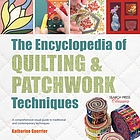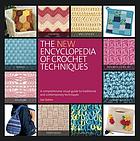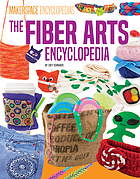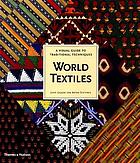About Encyclopedias
Encyclopedias cover vast amounts of information related to a specific subject. Here you can find some examples of encyclopedias concerning fiber and textile arts. Using encyclopedias can help researchers become more familiar with common terminology, theories, techniques, and perspectives relevant to the topic the text covers.
Each photo contains a link to their WorldCat profile, which provides more information about the text and where it can be found local to you.
The Encyclopedia of Quilting & Patchwork Techniques by Katharine Guerrier
The Encyclopedia o f Quilting & Patchwork Techniques by Katharine Guerrier covers introductory information concerning quilting and patchwork techniques. According to WorldCat the encyclopedia discusses "...tools, common cuts of fabric, rotary cutting, applique, finishing techniques, and common themes used in quilts, with examples from master quilters." (WorldCat, n.d.). Researchers can supplement their quilting research with information from this encyclopedia.
f Quilting & Patchwork Techniques by Katharine Guerrier covers introductory information concerning quilting and patchwork techniques. According to WorldCat the encyclopedia discusses "...tools, common cuts of fabric, rotary cutting, applique, finishing techniques, and common themes used in quilts, with examples from master quilters." (WorldCat, n.d.). Researchers can supplement their quilting research with information from this encyclopedia.
The New Encyclopedia of Crochet Techniques : A Comprehensive Visual Guide to Traditional and Contemporary Techniques by Jan Eaton
Authored by Jan Eaton in 2 012, Eaton provides readers with a comprehensive text for crocheters in The New Encyclopedia of Crochet Techniques. This encyclopedia goes in-depth regarding traditional and contemporary crochet techniques, stitches and patterns. This encyclopedia is accessible for beginners, as well as intermediate crafters. Researchers can supplement their research with this text as they develop a strong understanding of the craft's complexity. The text showcases patterns and projects created by artists at an international scale.
012, Eaton provides readers with a comprehensive text for crocheters in The New Encyclopedia of Crochet Techniques. This encyclopedia goes in-depth regarding traditional and contemporary crochet techniques, stitches and patterns. This encyclopedia is accessible for beginners, as well as intermediate crafters. Researchers can supplement their research with this text as they develop a strong understanding of the craft's complexity. The text showcases patterns and projects created by artists at an international scale.
The Fiber Arts Encyclopedia by Zoey Schrader
The Fiber Arts Encyclopedia is an a cademic and comprehensive text that covers a wide variety of fiber arts traditions; sewing, embroidery, crochet, knitting, etc. This text is particularly suitable for beginner crafters. Researchers can utilize this text to understand a broad range of practices, common tools, patterns, stitches, and safety measures. Researchers can apply this practical knowledge to the tradition of their choice, and they can develop a beginner level understanding of the process of some fiber arts techniques.
cademic and comprehensive text that covers a wide variety of fiber arts traditions; sewing, embroidery, crochet, knitting, etc. This text is particularly suitable for beginner crafters. Researchers can utilize this text to understand a broad range of practices, common tools, patterns, stitches, and safety measures. Researchers can apply this practical knowledge to the tradition of their choice, and they can develop a beginner level understanding of the process of some fiber arts techniques.
World Textiles : A Visual Guide to Traditional Techniques by John Gillow and Bryan Sentance
John Gillow and Br yan Sentance provide an authoritative and comprehensive analysis of world textiles in this encyclopedia. World Textiles delves into a wide variety of traditions and techniques spanning across the world, with an critical, analytical eye on the significance of geography, human civilization, and how these intertwine with fiber and textile arts. This text provides characterizations of fiber and textile traditions including weaving, embroidery, sewing and much more. Researchers may wish to use this encyclopedia to determine and narrow their research interests. This text can provide researchers with an anthropological and historical point of view.
yan Sentance provide an authoritative and comprehensive analysis of world textiles in this encyclopedia. World Textiles delves into a wide variety of traditions and techniques spanning across the world, with an critical, analytical eye on the significance of geography, human civilization, and how these intertwine with fiber and textile arts. This text provides characterizations of fiber and textile traditions including weaving, embroidery, sewing and much more. Researchers may wish to use this encyclopedia to determine and narrow their research interests. This text can provide researchers with an anthropological and historical point of view.
Textilepedia : The Complete Fabric Guide
Textilepedia: the com plete fabric guide was published in 2020 by Fashionary. This encyclopedia is concerned with the structure and development of materials into useable textiles. This text covers the different types of material used in textile and fiber arts. Researchers who are particularly interested in fashion or clothing, whether contemporary or historical, may find this encyclopedia useful. Understanding the different types of materials involved in the process can contextualize the various traditions and crafts researchers encounter, and the significance of each material anthropologically.
plete fabric guide was published in 2020 by Fashionary. This encyclopedia is concerned with the structure and development of materials into useable textiles. This text covers the different types of material used in textile and fiber arts. Researchers who are particularly interested in fashion or clothing, whether contemporary or historical, may find this encyclopedia useful. Understanding the different types of materials involved in the process can contextualize the various traditions and crafts researchers encounter, and the significance of each material anthropologically.